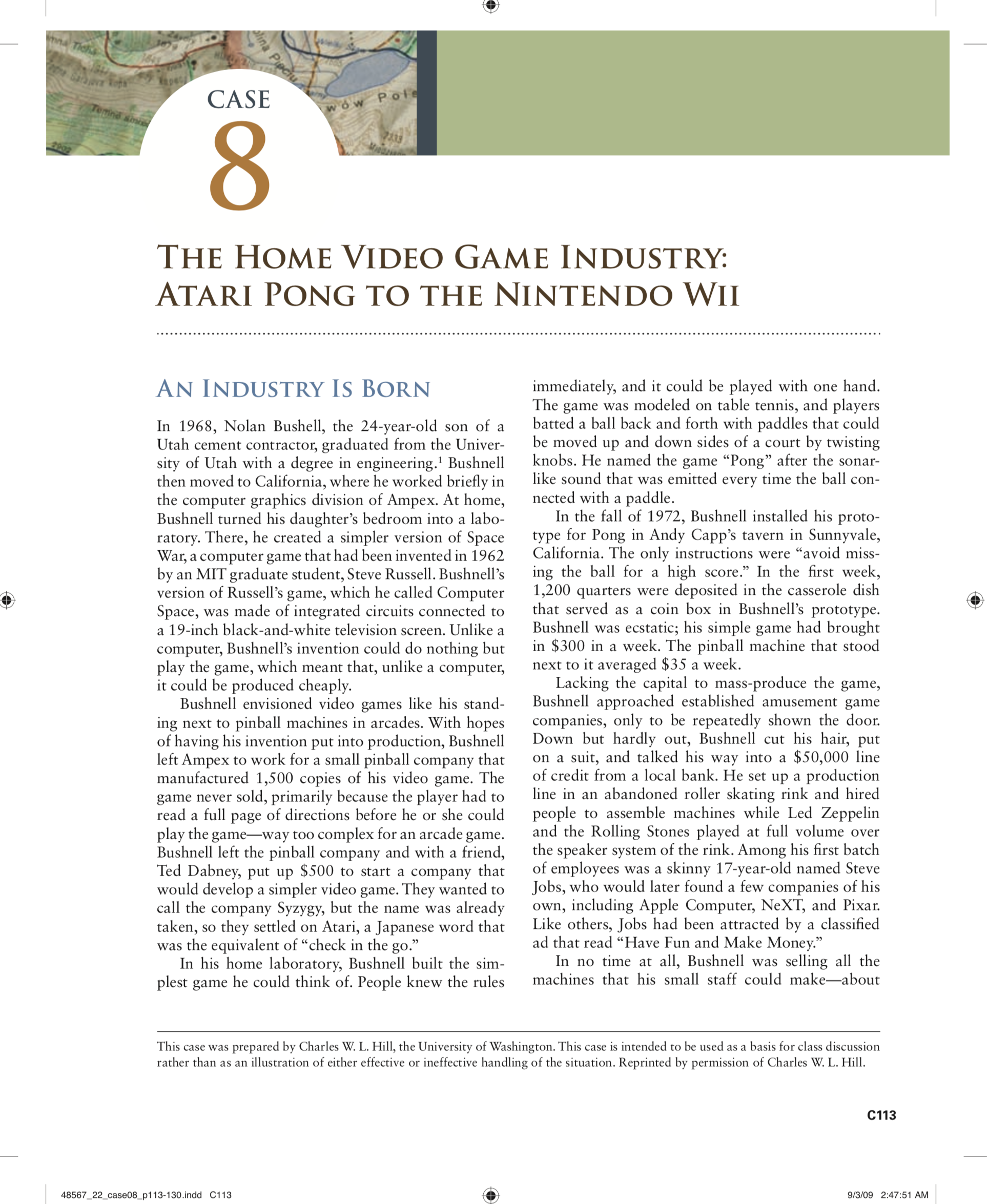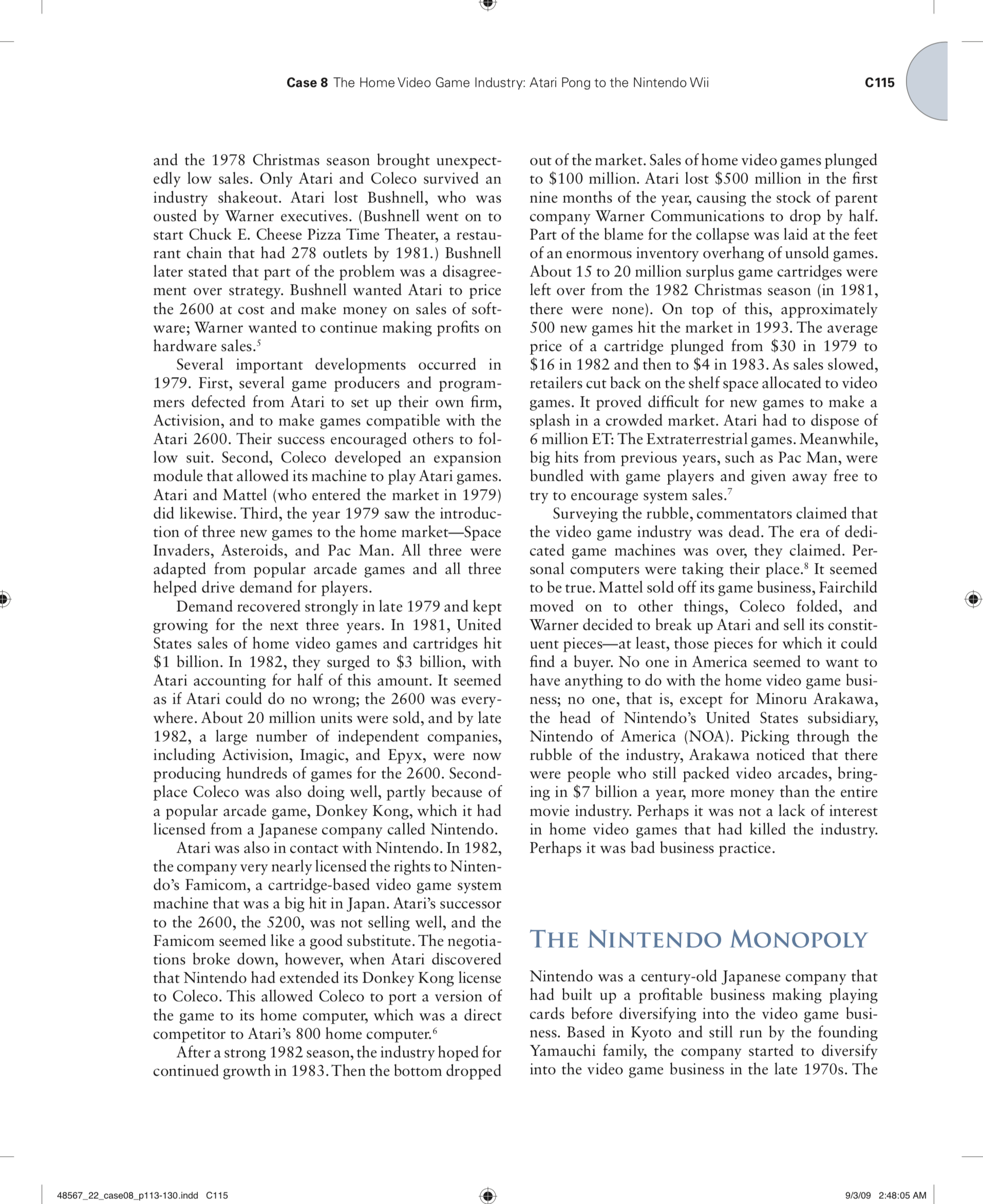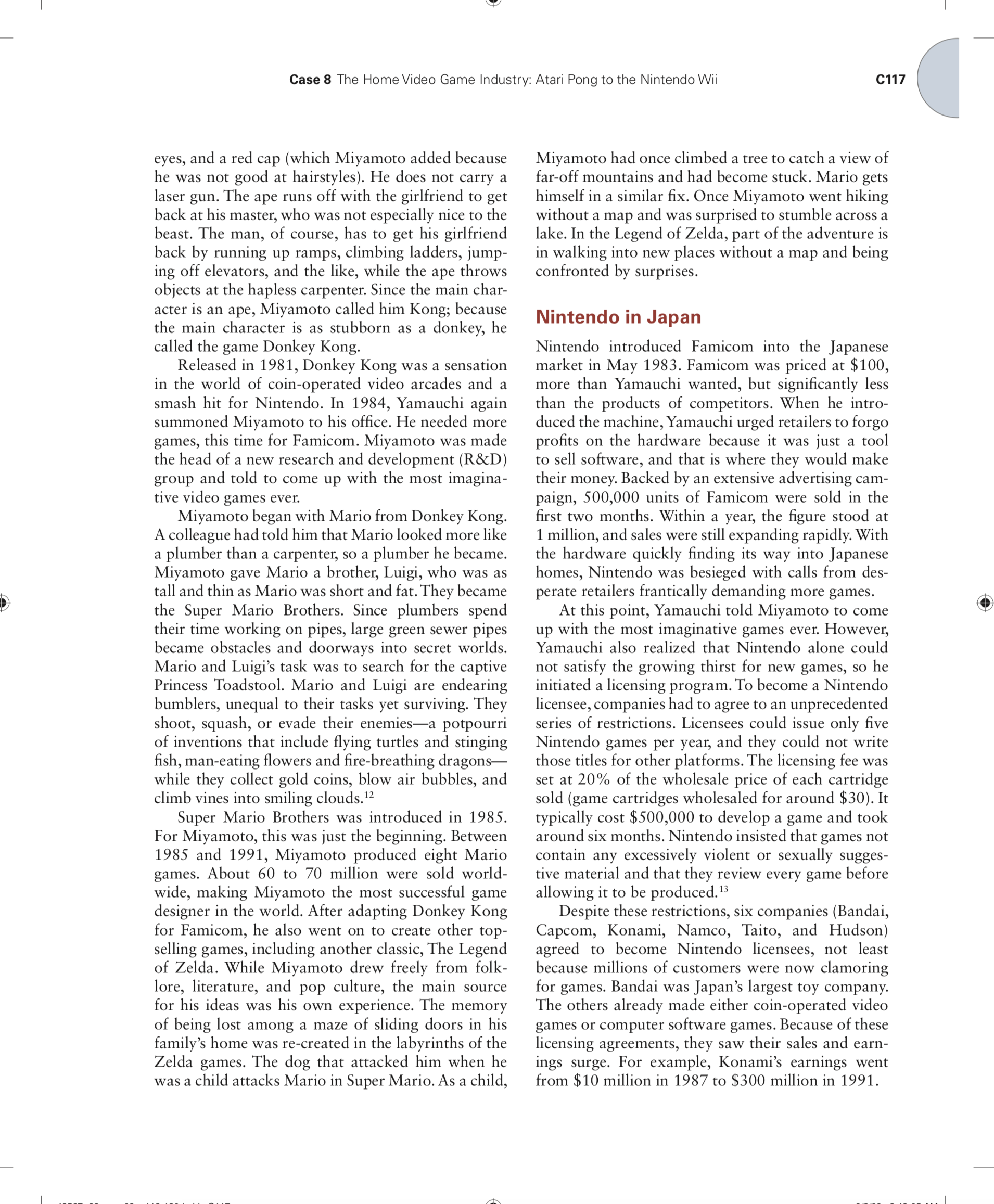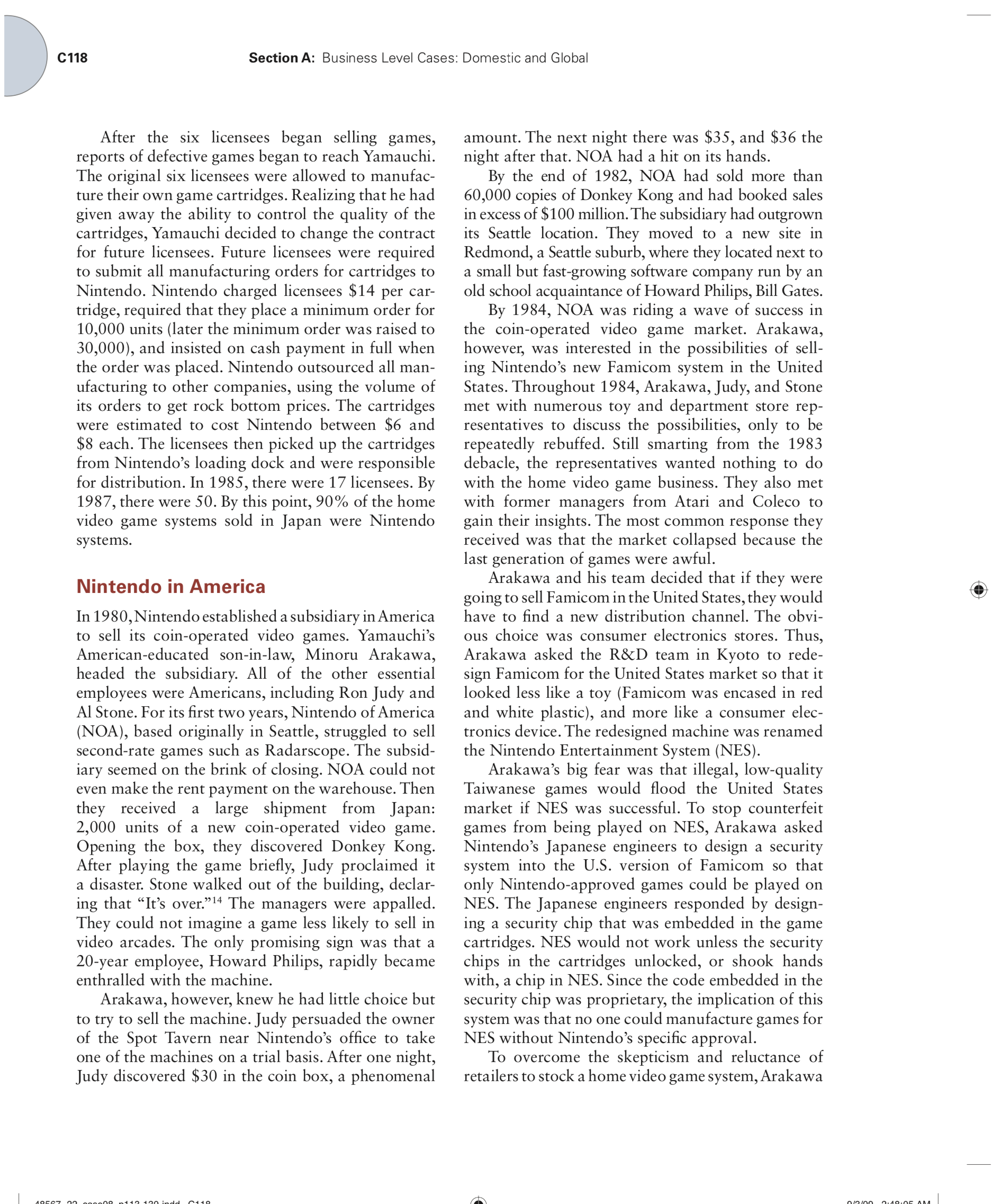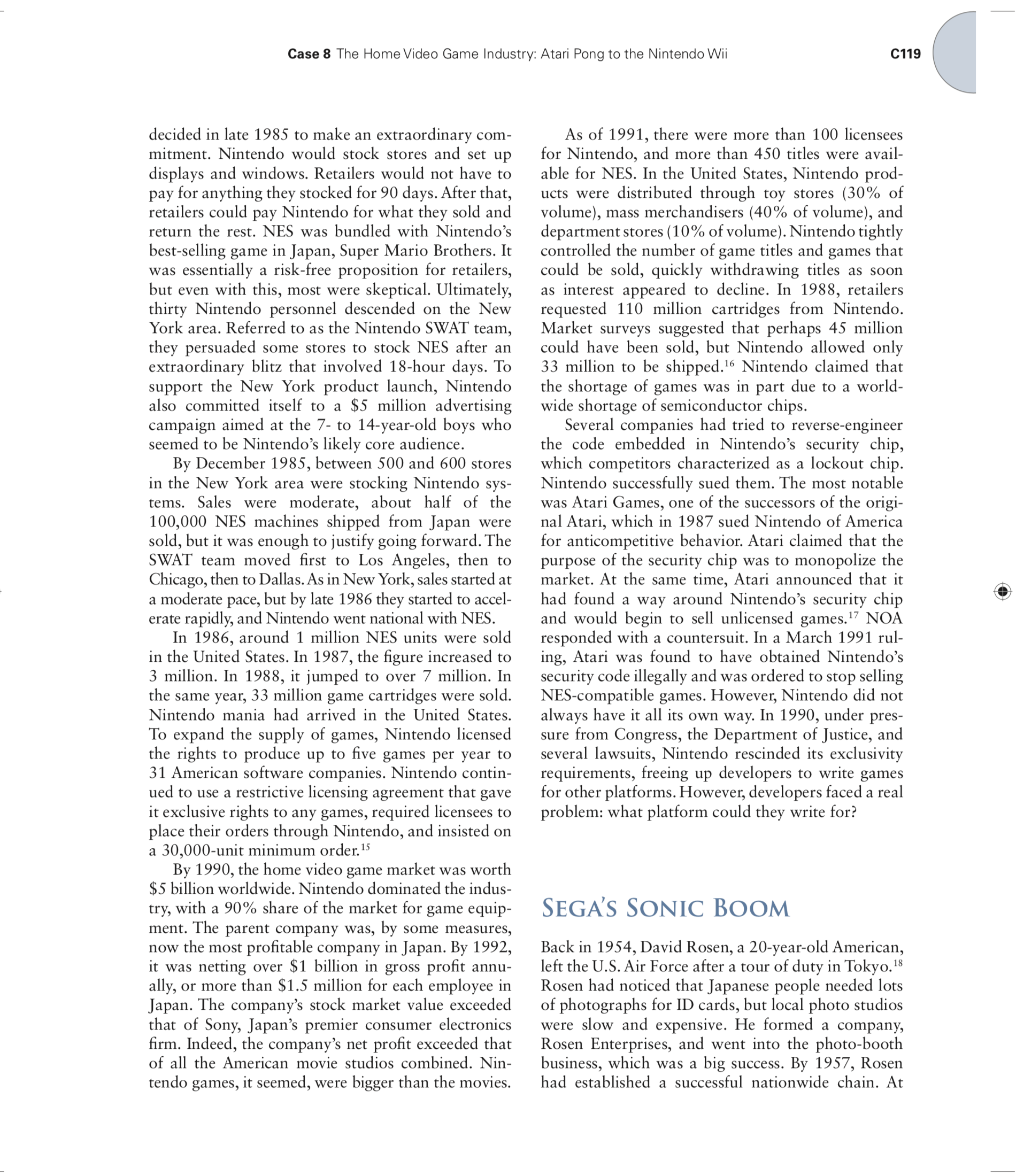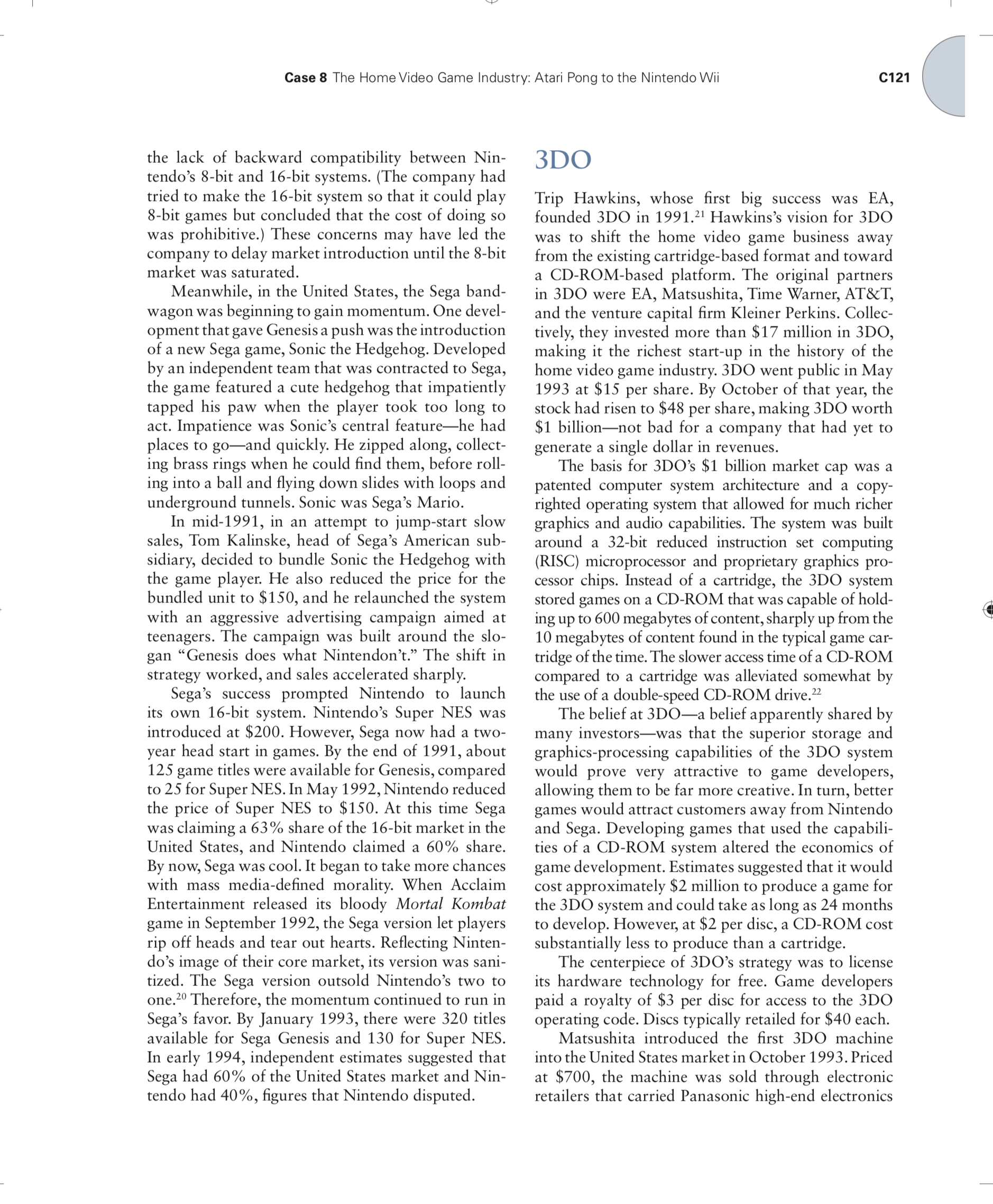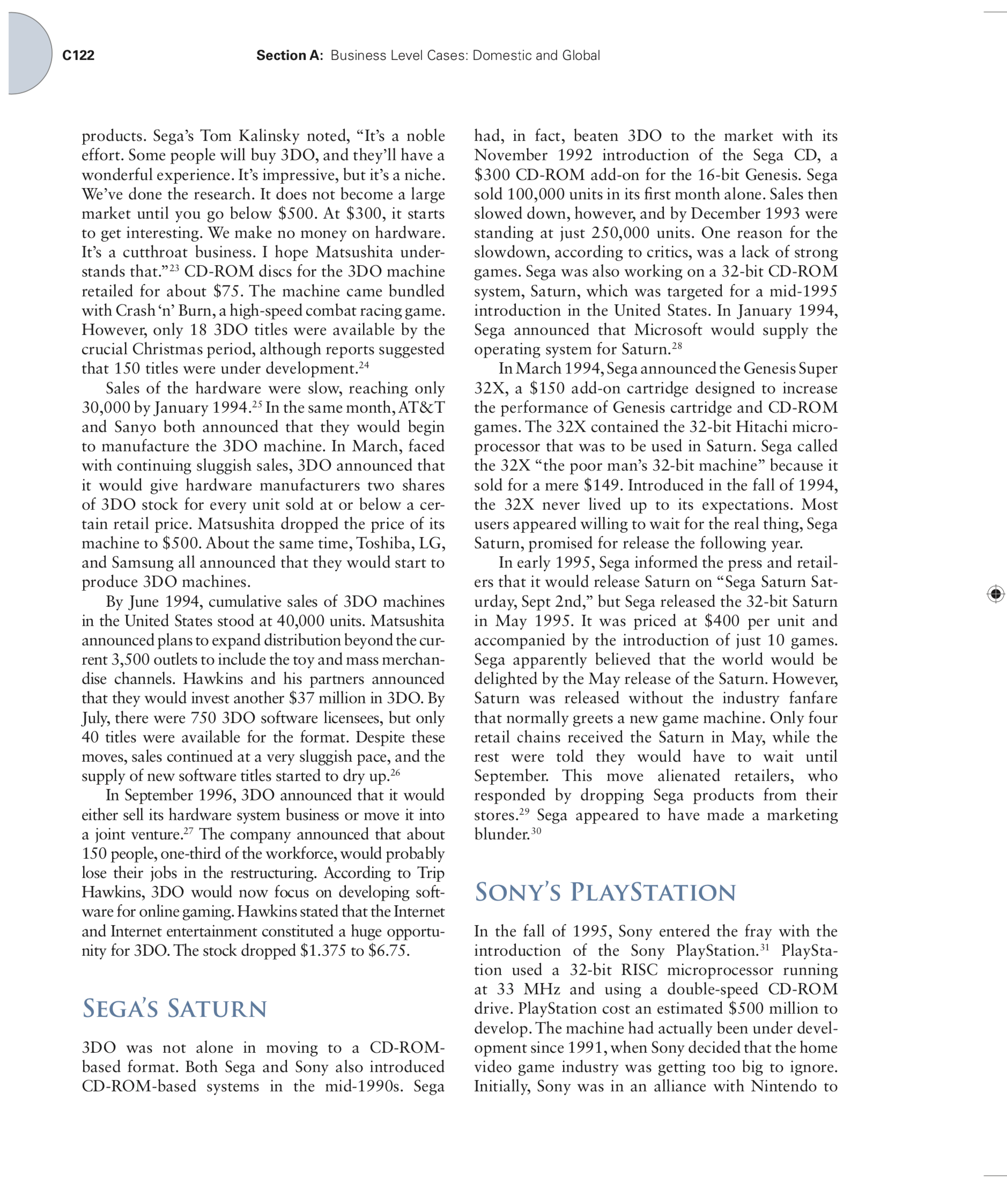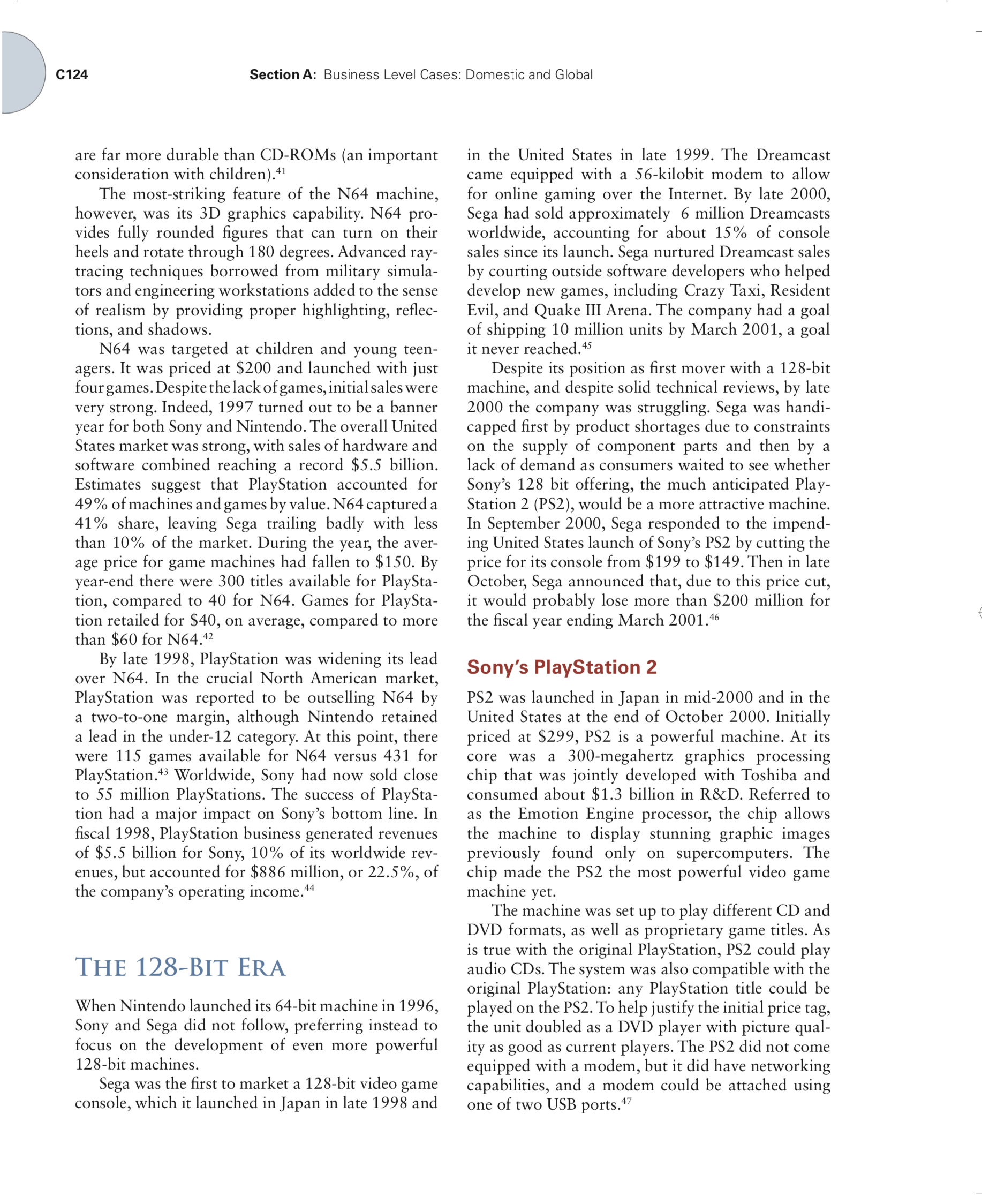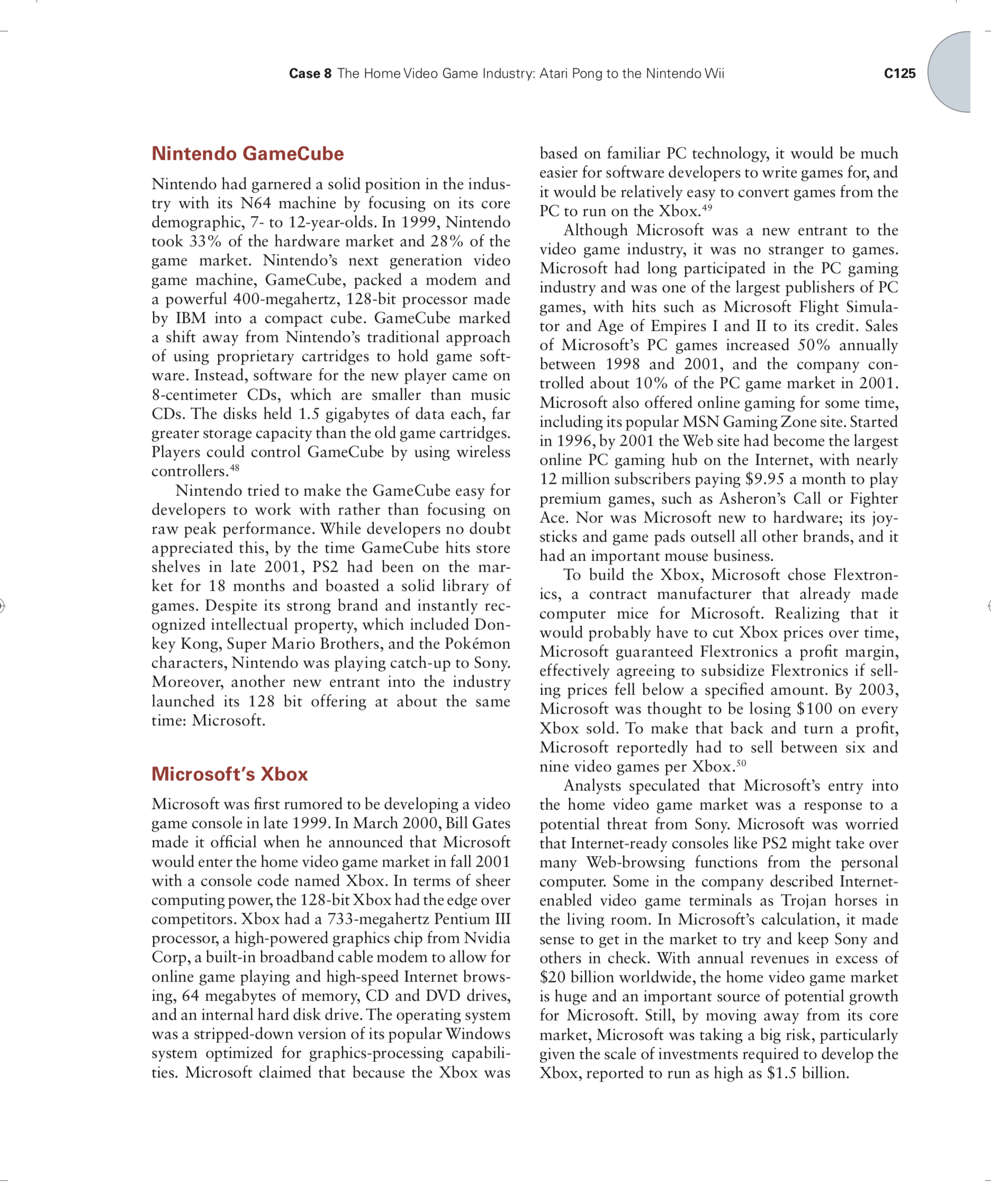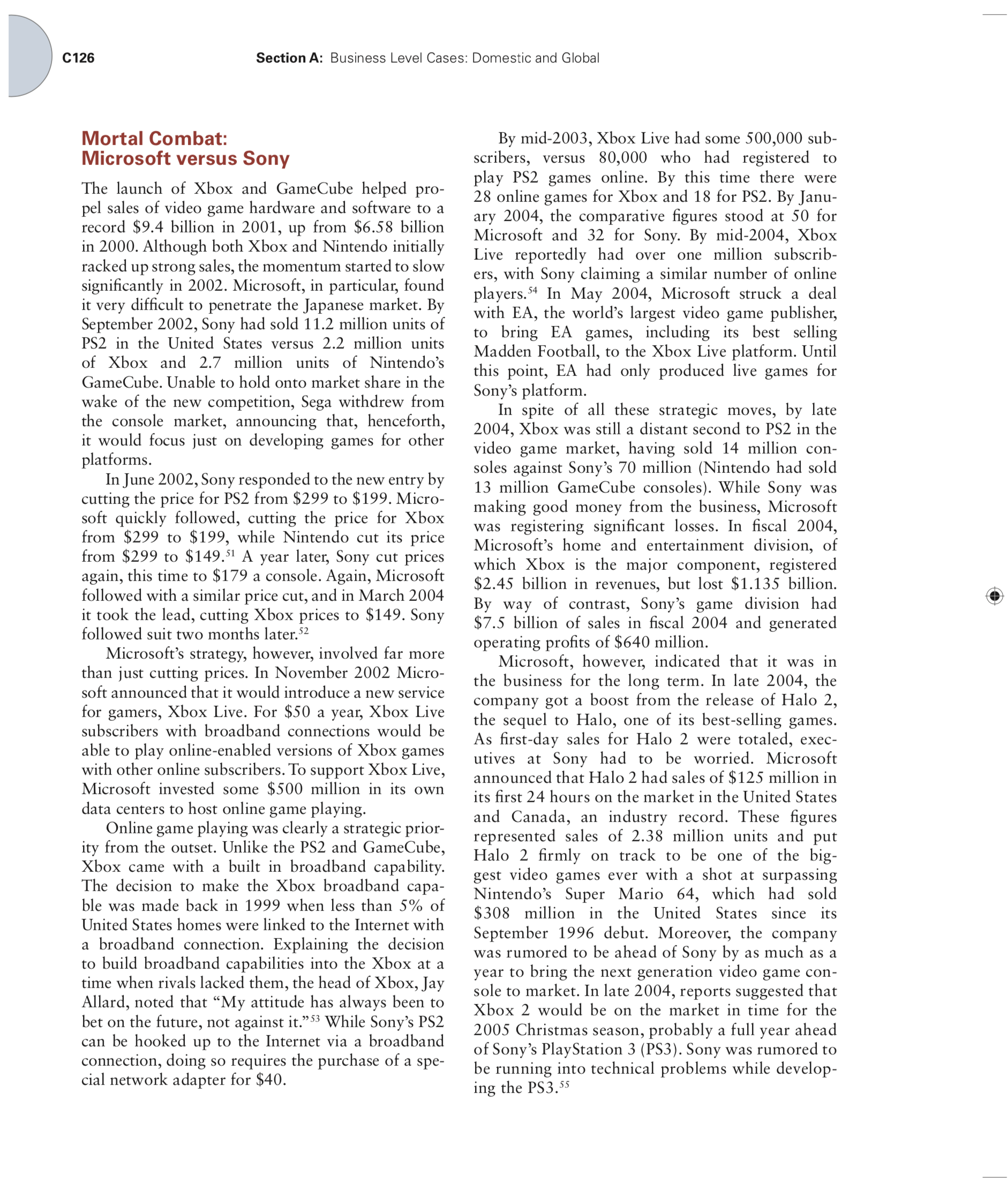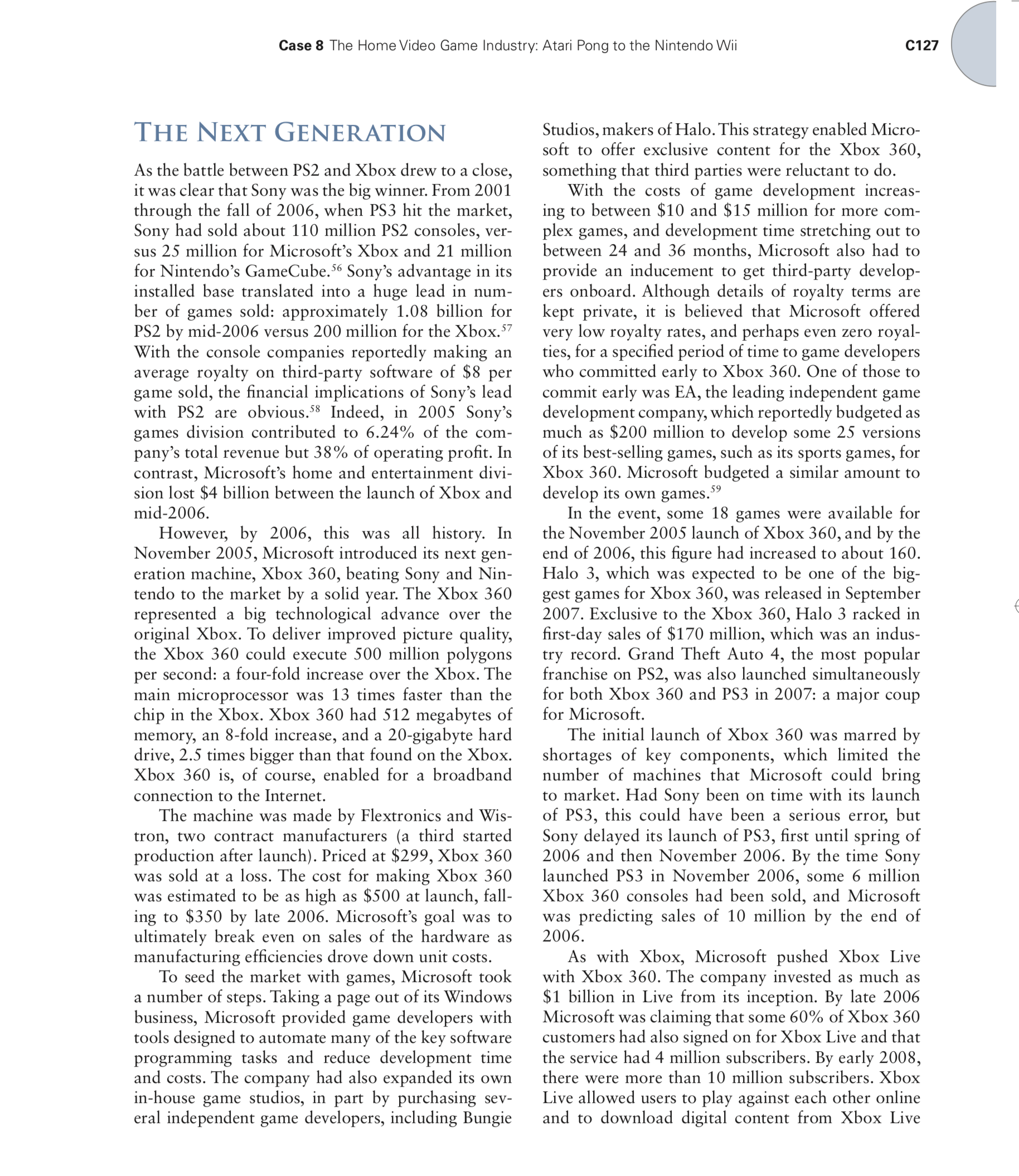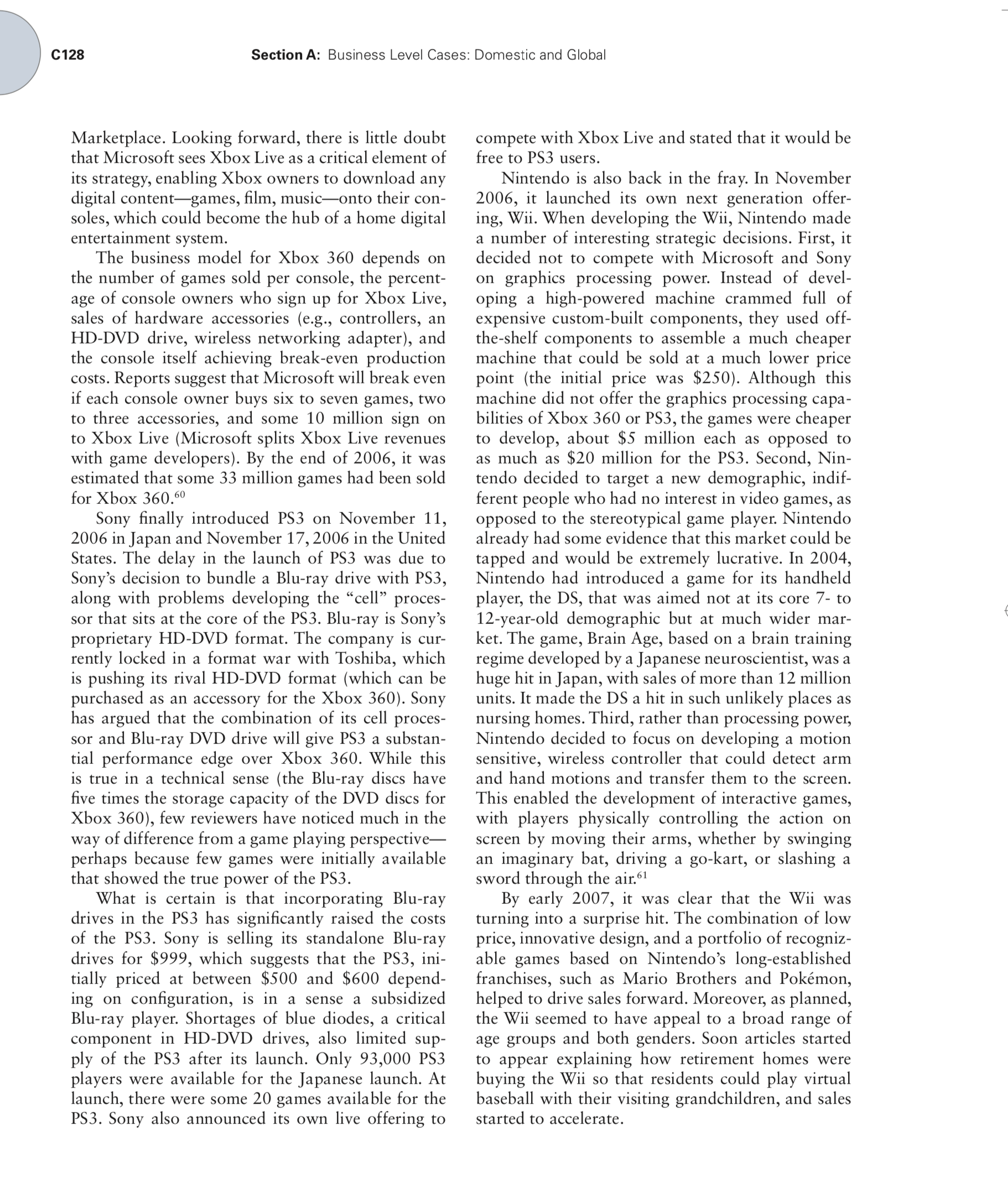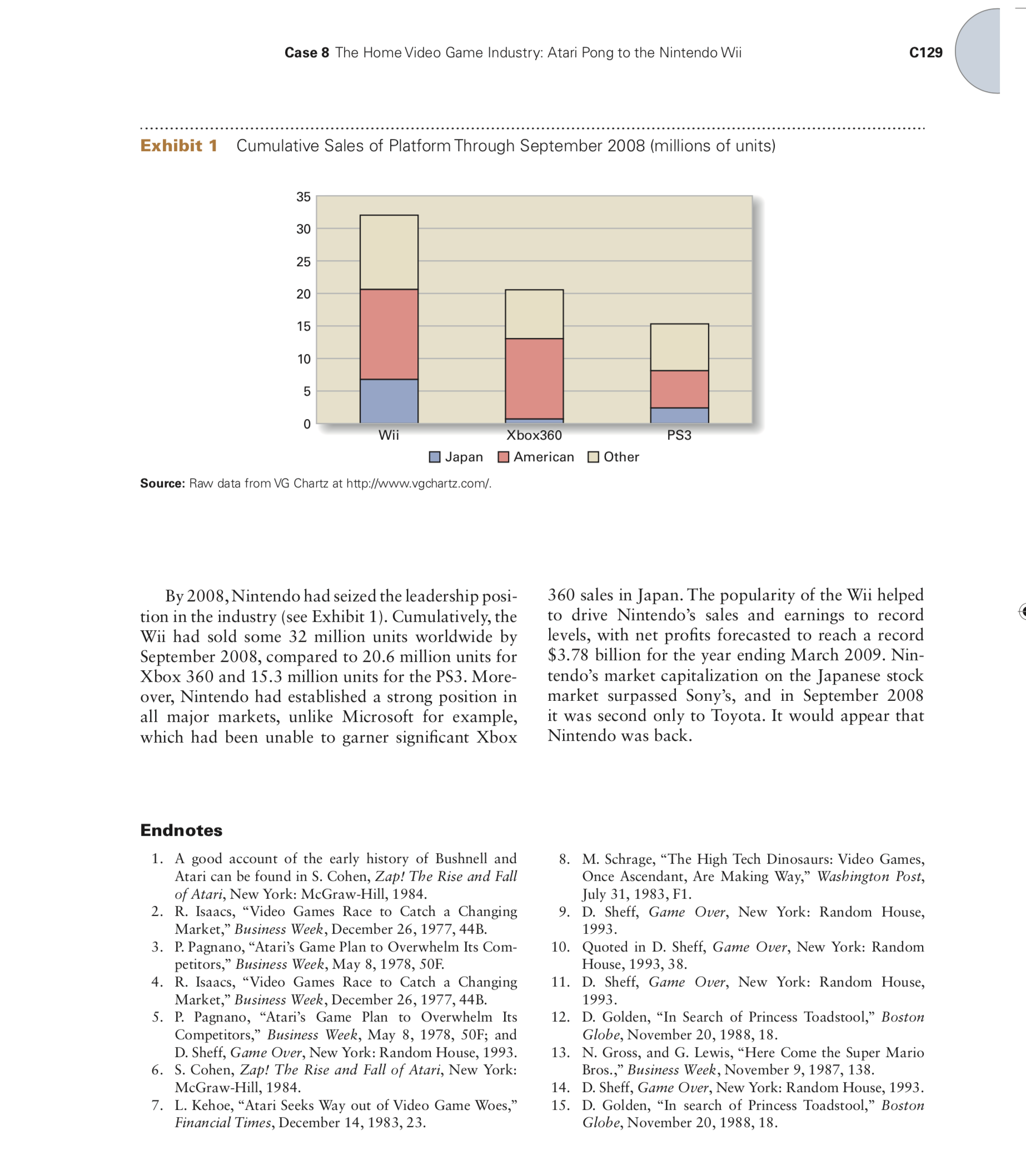Read the case study above and answer the following questions:
- How did Nintendo successfully recreate the home video game business following the Atari-era boom and bust?
- How was Nintendo able to capture value from the home video game business?
- How was Sega able to gain market share from Nintendo?
- Evaluate the competitive strategy of 3DO? What flaws can you see in 3DO's approach?
- Why has Sony PlayStation succeeded where 3DO failed?
- What drove Microsoft's decision to enter the industry with its Xbox offering?
- What lessons can be learnt from the history of the home video game industry that were used to help launch the Sony PlayStation II and Microsoft's Xbox? Do Microsoft and Sony appear to have learnt and applied these lessons?
- Evaluate the introduction of the Xbox 360, Sony PlayStation 3, and Nintendo's Wii. What lessons can be learned from these events? How did Nintendo reestablish itself in this market with the Wii?
THE HOME VIDEO GAME INDUSTRY: ATARI PONG TO THE NINTENDO WII AN INDUSTRY IS BORN In 1968, Nolan Bushell, the 24-year-old son of a Utah cement contractor, graduated from the Univer- sity of Utah with a degree in engineering.1 Bushnell then moved to California, where he worked briey in the computer graphics division of Ampex. At home, Bushnell turned his daughter's bedroom into a labo- ratory. There, he created a simpler version of Space War, a computer game that had been invented in 1962 by an MIT graduate student, Steve Russell. Bushnell's version of Russell's game, which he called Computer Space, was made of integrated circuits connected to a 19-inch black-and-white television screen. Unlike a computer, Bushnell's invention could do nothing but play the game, which meant that, unlike a computer, it could be produced cheaply. Bushnell envisioned video games like his stand- ing next to pinball machines in arcades. With hopes of having his invention put into production, Bushnell left Ampex to work for a small pinball company that manufactured 1,500 copies of his video game. The game never sold, primarily because the player had to read a full page of directions before he or she could play the gameway too complex for an arcade game. Bushnell left the pinball company and with a friend, Ted Dabney, put up $500 to start a company that would develop a simpler video game. They wanted to call the company Syzygy, but the name was already taken, so they settled on Atari, a Japanese word that was the equivalent of \"check in the go.\" In his home laboratory, Bushnell built the sim- plest game he could think of. People knew the rules immediately, and it could be played with one hand. The game was modeled on table tennis, and players batted a ball back and forth with paddles that could be moved up and down sides of a court by twisting knobs. He named the game \"Pong\" after the sonar- like sound that was emitted every time the ball con- nected with a paddle. In the fall of 1972, Bushnell installed his proto- type for Pong in Andy Capp's tavern in Sunnyvale, California. The only instructions were \"avoid miss- ing the ball for a high score.\" In the first week, 1,200 quarters were deposited in the casserole dish that served as a coin box in Bushnell's prototype. Bushnell was ecstatic; his simple game had brought in $300 in a week. The pinball machine that stood next to it averaged $35 a week. Lacking the capital to mass-produce the game, Bushnell approached established amusement game companies, only to be repeatedly shown the door. Down but hardly out, Bushnell cut his hair, put on a suit, and talked his way into a $50,000 line of credit from a local bank. He set up a production line in an abandoned roller skating rink and hired people to assemble machines while Led Zeppelin and the Rolling Stones played at full volume over the speaker system of the rink. Among his rst batch of employees was a skinny 17-year-old named Steve Jobs, who would later found a few companies of his Own, including Apple Computer, NeXT, and Pixar. Like others, Jobs had been attracted by a classied ad that read \"Have Fun and Make Money.\" In no time at all, Bushnell was selling all the machines that his small staff could makeabout This case was prepared by Charles W. L. Hill, the University of Washington. This case is intended to be used as a basis for class discussion rather than as an illustration of either effective or ineffective handling of the situation. Reprinted by permission of Charles W. L. Hill. 4ass7_22_caseoa_pi 13130.indd Cl 13 C113 9/8/09 2:47:51 AM C 114 Section A: Business Level Cases: Domestic and Global 10 per day; to grow, however, he needed additional graphics processing capabilities. It was designed to capital. The ambience at the rink, with its mix of rock receive information from the controllers, process it, music and marijuana fumes, put off most potential and send signals to a television monitor. The control- investors, but Don Valentine, one of the country's lers were handheld devices used to direct on-screen most astute and credible venture capitalists, was action. The cartridges contained chips encoding the impressed with the growth story. Armed with instructions for a game. The cartridges were designed Valentine's money, Atari began to increase produc- to be inserted into the console. tion and expand its range of games. New games In 1976, Bushnell sold Atari to Warner Com- included Tank and Breakout; the latter was designed munications for $28 million. Bushnell stayed on to by Jobs and a friend of his, Steve Wozniak, who had run Atari. Backed by Warner's capital, in 1977, Atari left Hewlett-Packard to work at Atari. developed and brought out its own cartridge-based By 1974, 100,000 Pong-like games were sold system, the Atari 2600. The 2600 system was sold worldwide. Although Atari manufactured only for $200, and associated cartridges retailed for 10% of the games, the company still made $25 to $35. Sales surged during the 1977 Christmas $3.2 million that year. With the Pong clones coming season. However, a lack of manufacturing capac- on strong, Bushnell decided to make a Pong system ty on the part of market-leader Atari and a very for the home. In fact, Magnavox had been marketing cautious approach to inventory by Fairchild led to a similar game for the home since 1972, although shortages and kept sales significantly below what sales had been modest. Bushnell's team managed they could have been. Fairchild's cautious approach to compress Atari's coin-operated Pong game down was the result of prior experience in consumer elec- to a few inexpensive circuits that were contained in tronics. A year earlier, it had increased demand for the game console. Atari's Pong had a sharper pic- its digital watches, only to accumulate a buildup of ture and more sensitive controllers than Magnavox's excess inventory that had caused the company to machine. It also cost less. Bushnell then went on a take a $24.5 million write-off.' road show, demonstrating Pong to toy buyers, but After the 1977 Christmas season, Atari claimed he received an indifferent response and no sales. to have sold about 400,000 units of the A dejected Bushnell returned to Atari with no idea 2600 VCA, about 50% of all cartridge-based systems of what to do next. Then the buyer for the sport- in American homes. Atari had also earned more than ing goods department at Sears came to see Bushnell, $100 million in sales of game cartridges. By this point, reviewed the machine, and offered to buy every home second-place Fairchild sold about 250,000 units of Pong game Atari could make. With Sears's backing, its system. Cartridge sales for the year totaled about Bushnell boosted production. Sears ran a major tele- 1.2 million units, with an average selling price of vision ad campaign to sell home Pong, and Atari's about $20. Fresh from this success and fortified by sales soared, hitting $450 million in 1975. The home market forecasts predicting sales of 33 million car- video game had arrived tridges and an installed base of 16 million machines by 1980, Bushnell committed Atari to manufacturing 1 million units of the 2600 for the 1978 Christmas season. Atari estimated that total demand would BOOM AND BUST reach 2 million units. Bushnell was also encouraged by signals from Fairchild that it would again be lim- Nothing attracts competitors like success, and by iting production to approximately 200,000 units. At 1976 about 20 different companies were crowd- this point, Atari had a library of nine games, while ing into the home video game market, including Fairchild had 17 games.* National Semiconductor, RCA, Coleco, and Fair- Atari was not the only company to be excited by child. Recognizing the limitations of existing home the growth forecasts. In 1978, a host of other com- video game designs, in 1976, Fairchild came out with panies, including Coleco, National Semiconductor, a home video game system capable of playing mul- Magnavox, General Instrument, and a dozen other tiple games. The Fairchild system consisted of three companies, entered the market with incompatible components-a console, controllers, and cartridges. cartridge-based home systems. The multitude of The console was a small computer optimized for choices did not seem to entice consumers, however,Case 8 The Home Video Game Industry: Atari Pong to the Nintendo Wii C 115 and the 1978 Christmas season brought unexpect- out of the market. Sales of home video games plunged edly low sales. Only Atari and Coleco survived an to $100 million. Atari lost $500 million in the first industry shakeout. Atari lost Bushnell, who was nine months of the year, causing the stock of parent ousted by Warner executives. (Bushnell went on to company Warner Communications to drop by half. start Chuck E. Cheese Pizza Time Theater, a restau- Part of the blame for the collapse was laid at the feet rant chain that had 278 outlets by 1981.) Bushnell of an enormous inventory overhang of unsold games. later stated that part of the problem was a disagree- About 15 to 20 million surplus game cartridges were ment over strategy. Bushnell wanted Atari to price left over from the 1982 Christmas season (in 1981, the 2600 at cost and make money on sales of soft- there were none). On top of this, approximately ware; Warner wanted to continue making profits on 500 new games hit the market in 1993. The average hardware sales. price of a cartridge plunged from $30 in 1979 to Several important developments occurred in $16 in 1982 and then to $4 in 1983. As sales slowed, 1979. First, several game producers and program- retailers cut back on the shelf space allocated to video mers defected from Atari to set up their own firm, games. It proved difficult for new games to make a Activision, and to make games compatible with the splash in a crowded market. Atari had to dispose of Atari 2600. Their success encouraged others to fol- 6 million ET: The Extraterrestrial games. Meanwhile, low suit. Second, Coleco developed an expansion big hits from previous years, such as Pac Man, were module that allowed its machine to play Atari games. bundled with game players and given away free to Atari and Mattel (who entered the market in 1979) try to encourage system sales." did likewise. Third, the year 1979 saw the introduc- Surveying the rubble, commentators claimed that tion of three new games to the home market-Space the video game industry was dead. The era of dedi- Invaders, Asteroids, and Pac Man. All three were cated game machines was over, they claimed. Per- adapted from popular arcade games and all three sonal computers were taking their place. It seemed helped drive demand for players. to be true. Mattel sold off its game business, Fairchild Demand recovered strongly in late 1979 and kept moved on to other things, Coleco folded, and growing for the next three years. In 1981, United Warner decided to break up Atari and sell its constitu States sales of home video games and cartridges hit uent pieces-at least, those pieces for which it could $1 billion. In 1982, they surged to $3 billion, with find a buyer. No one in America seemed to want to Atari accounting for half of this amount. It seemed have anything to do with the home video game busi- as if Atari could do no wrong; the 2600 was every- ness; no one, that is, except for Minoru Arakawa, where. About 20 million units were sold, and by late the head of Nintendo's United States subsidiary, 1982, a large number of independent companies, Nintendo of America (NOA). Picking through the including Activision, Imagic, and Epyx, were now rubble of the industry, Arakawa noticed that there producing hundreds of games for the 2600. Second- were people who still packed video arcades, bring- place Coleco was also doing well, partly because of ing in $7 billion a year, more money than the entire a popular arcade game, Donkey Kong, which it had movie industry. Perhaps it was not a lack of interest licensed from a Japanese company called Nintendo. in home video games that had killed the industry. Atari was also in contact with Nintendo. In 1982, Perhaps it was bad business practice. the company very nearly licensed the rights to Ninten- do's Famicom, a cartridge-based video game system machine that was a big hit in Japan. Atari's successor to the 2600, the 5200, was not selling well, and the Famicom seemed like a good substitute. The negotia- THE NINTENDO MONOPOLY ions broke down, however, when Atari discovered that Nintendo had extended its Donkey Kong license Nintendo was a century-old Japanese company that to Coleco. This allowed Coleco to port a version of had built up a profitable business making playing the game to its home computer, which was a direct cards before diversifying into the video game busi- competitor to Atari's 800 home computer. ness. Based in Kyoto and still run by the founding After a strong 1982 season, the industry hoped for Yamauchi family, the company started to diversify continued growth in 1983. Then the bottom dropped into the video game business in the late 1970s. The 48567_22_case08_p113-130.indd C115 9/3/09 2:48:05 AMC116 Section A: Business Level Cases: Domestic and Global first step was to license video game technology from sophisticated and complex games had arrived. Over Magnavox. In 1977, Nintendo introduced a home time, Nintendo's engineers developed more power- video game system in Japan based on this technology ful MMC chips, enabling the basic 8-bit system to that played a variation of Pong. In 1978, the com- do things that originally seemed out of reach. The pany began to sell coin-operated video games. It had engineers also figured out a way to include a bat- its first hit with Donkey Kong, designed by Sigeru tery backup system in cartridges that allowed some Miyamoto. games to store information independently-to keep track of where a player had left off or track high The Famicom scores. In the early 1980s, the company's boss, Hiroshi Yamauchi, decided that Nintendo had to develop its The Games own video game machine. He pushed the company's Yamauchi recognized that great hardware would not engineers to develop a machine that combined supe- sell itself. The key to the market, he reasoned, was rior graphics-processing capabilities and low cost. great games. Yamauchi had instructed the engineers, Yamauchi wanted a machine that could sell for $75, as they were developing the hardware, to make sure less than half the price of competing machines at the that "it was appreciated by software engineers." time. He dubbed the machine the Family Computer, Nintendo decided that it would become a haven for or Famicom. The machine that his engineers designed game designers. "An ordinary man," Yamauchi said, was based on the controller, console, and plug-in 'cannot develop good games no matter how hard he cartridge format pioneered by Fairchild. It contained tries. A handful of people in this world can develop two custom chips-an 8-bit central processing unit games that everyone wants. Those are the people we and a graphics-processing unit. Both chips had been want at Nintendo."10 scaled down to perform only essential functions. Yamauchi had an advantage in the person of A 16-bit processor was available at the time, but to Sigeru Miyamoto. Miyamoto had joined Nintendo keep costs down, Yamauchi refused to use it. at the age of 24. Yamauchi had hired Miyamoto, Nintendo approached Ricoh, the electronics giant, a graduate of Kanazawa Munici College of Indus which had spare semiconductor capacity. Employees trial Arts, as a favor to his father and an old friend, at Ricoh said that the chips had to cost no more that although he had little idea what he would do with 2,000 yen. Ricoh thought that the 2,000-yen price an artist. For three years, Miyamoto worked as Nin- point was absurd. Yamauchi's response was to guar- tendo's staff artist. Then in 1980, Yamauchi called antee Ricoh a 3-million-chip order within two years. Miyamoto into his office. Nintendo had started sell- Since the leading companies in Japan were selling, at ing coin-operated video games, but one of the new most, 30,000 video games per year at the time, many games, Radarscope, was a disaster. Could Miyamoto within the company viewed this as an outrageous come up with a new game? Miyamoto was delighted. commitment, but Ricoh went for it." He had always spent a lot of time drawing cartoons, Another feature of the machine was its and as a student, he had played video games con- memory-2,000 bytes of random access memory stantly. Miyamoto believed that video games could (RAM), compared to the 256 bytes of RAM in be used to bring cartoons to life. " the Atari machine. The result was a machine with The game Miyamoto developed was nothing short superior graphics-processing capabilities and faster of a revelation. At a time when most coin-operated action that could handle far more complex games video games lacked characters or depth, Miyamoto than Atari games. Nintendo's engineers also built a created a game around a story that had both. Most new set of chips into the game cartridges. In addi- games involved battles with space invaders or heroes tion to chips that held the game program, Nintendo shooting lasers at aliens; Miyamoto's game did nei- developed memory map controller (MMC) chips ther. Based loosely on Beauty and the Beast and King that took over some of the graphics-processing Kong, Miyamoto's game involved a pet ape who runs work from the chips in the console and enabled the off with his master's beautiful girlfriend. His master system to handle more complex games. With the is an ordinary carpenter called Mario, who has a bul- addition of the MMC chips, the potential for more- bous nose, a bushy mustache, a pair of large patheticCase 8 The Home Video Game Industry: Atari Pong to the Nintendo Wii C117 eyes, and a red cap (which Miyamoto added because Miyamoto had once climbed a tree to catch a view of he was not good at hairstyles). He does not carry a far-off mountains and had become stuck. Mario gets laser gun. The ape runs off with the girlfriend to get himself in a similar fix. Once Miyamoto went hiking back at his master, who was not especially nice to the without a map and was surprised to stumble across a beast. The man, of course, has to get his girlfriend lake. In the Legend of Zelda, part of the adventure is back by running up ramps, climbing ladders, jump- in walking into new places without a map and being ing off elevators, and the like, while the ape throws confronted by surprises. objects at the hapless carpenter. Since the main char- acter is an ape, Miyamoto called him Kong; because the main character is as stubborn as a donkey, he Nintendo in Japan called the game Donkey Kong. Nintendo introduced Famicom into the Japanese Released in 1981, Donkey Kong was a sensation market in May 1983. Famicom was priced at $100, in the world of coin-operated video arcades and a more than Yamauchi wanted, but significantly less smash hit for Nintendo. In 1984, Yamauchi again than the products of competitors. When he intro- summoned Miyamoto to his office. He needed more duced the machine, Yamauchi urged retailers to forgo games, this time for Famicom. Miyamoto was made profits on the hardware because it was just a tool the head of a new research and development (R&D) to sell software, and that is where they would make group and told to come up with the most imagina- their money. Backed by an extensive advertising cam- tive video games ever. paign, 500,000 units of Famicom were sold in the Miyamoto began with Mario from Donkey Kong. first two months. Within a year, the figure stood at A colleague had told him that Mario looked more like 1 million, and sales were still expanding rapidly. With a plumber than a carpenter, so a plumber he became. the hardware quickly finding its way into Japanese Miyamoto gave Mario a brother, Luigi, who was as homes, Nintendo was besieged with calls from des- tall and thin as Mario was short and fat. They became perate retailers frantically demanding more games. the Super Mario Brothers. Since plumbers spend At this point, Yamauchi told Miyamoto to come their time working on pipes, large green sewer pipes up with the most imaginative games ever. However, became obstacles and doorways into secret worlds. Yamauchi also realized that Nintendo alone could Mario and Luigi's task was to search for the captive not satisfy the growing thirst for new games, so he Princess Toadstool. Mario and Luigi are endearing initiated a licensing program. To become a Nintendo bumblers, unequal to their tasks yet surviving. They licensee, companies had to agree to an unprecedented shoot, squash, or evade their enemies-a potpourri series of restrictions. Licensees could issue only five of inventions that include flying turtles and stinging Nintendo games per year, and they could not write fish, man-eating flowers and fire-breathing dragons- those titles for other platforms. The licensing fee was while they collect gold coins, blow air bubbles, and set at 20% of the wholesale price of each cartridge climb vines into smiling clouds. 12 sold (game cartridges wholesaled for around $30). It Super Mario Brothers was introduced in 1985. typically cost $500,000 to develop a game and took For Miyamoto, this was just the beginning. Between around six months. Nintendo insisted that games not 1985 and 1991, Miyamoto produced eight Mario contain any excessively violent or sexually suggest games. About 60 to 70 million were sold world- tive material and that they review every game before wide, making Miyamoto the most successful game allowing it to be produced. 13 designer in the world. After adapting Donkey Kong Despite these restrictions, six companies (Bandai, for Famicom, he also went on to create other top- Capcom, Konami, Namco, Taito, and Hudson) selling games, including another classic, The Legend agreed to become Nintendo licensees, not least of Zelda. While Miyamoto drew freely from folk- because millions of customers were now clamoring lore, literature, and pop culture, the main source for games. Bandai was Japan's largest toy company. for his ideas was his own experience. The memory The others already made either coin-operated video of being lost among a maze of sliding doors in his games or computer software games. Because of these family's home was re-created in the labyrinths of the licensing agreements, they saw their sales and earn- Zelda games. The dog that attacked him when he ings surge. For example, Konami's earnings went was a child attacks Mario in Super Mario. As a child, from $10 million in 1987 to $300 million in 1991.C118 Section A: Business Level Cases: Domestic and Global After the six licensees began selling games, amount. The next night there was $35, and $36 the reports of defective games began to reach Yamauchi. night after that. NOA had a hit on its hands. The original six licensees were allowed to manufac By the end of 1982, NOA had sold more than ture their own game cartridges. Realizing that he had 60,000 copies of Donkey Kong and had booked sales given away the ability to control the quality of the in excess of $100 million. The subsidiary had outgrown cartridges, Yamauchi decided to change the contract its Seattle location. They moved to a new site in for future licensees. Future licensees were required Redmond, a Seattle suburb, where they located next to to submit all manufacturing orders for cartridges to a small but fast-growing software company run by an Nintendo. Nintendo charged licensees $14 per car- old school acquaintance of Howard Philips, Bill Gates. tridge, required that they place a minimum order for By 1984, NOA was riding a wave of success in 10,000 units (later the minimum order was raised to the coin-operated video game market. Arakawa, 30,000), and insisted on cash payment in full when however, was interested in the possibilities of sell- the order was placed. Nintendo outsourced all man- ing Nintendo's new Famicom system in the United ufacturing to other companies, using the volume of States. Throughout 1984, Arakawa, Judy, and Stone its orders to get rock bottom prices. The cartridges met with numerous toy and department store rep- were estimated to cost Nintendo between $6 and resentatives to discuss the possibilities, only to be $8 each. The licensees then picked up the cartridges repeatedly rebuffed. Still smarting from the 1983 from Nintendo's loading dock and were responsible debacle, the representatives wanted nothing to do for distribution. In 1985, there were 17 licensees. By with the home video game business. They also met 1987, there were 50. By this point, 90% of the home with former managers from Atari and Coleco to video game systems sold in Japan were Nintendo gain their insights. The most common response they systems. received was that the market collapsed because the last generation of games were awful. Nintendo in America Arakawa and his team decided that if they were going to sell Famicom in the United States, they would In 1980, Nintendo established a subsidiary in America have to find a new distribution channel. The obvi- to sell its coin-operated video games. Yamauchi's ous choice was consumer electronics stores. Thus, American-educated son-in-law, Minoru Arakawa, Arakawa asked the R&D team in Kyoto to rede- headed the subsidiary. All of the other essential sign Famicom for the United States market so that it employees were Americans, including Ron Judy and looked less like a toy (Famicom was encased in red Al Stone. For its first two years, Nintendo of America and white plastic), and more like a consumer elec- (NOA), based originally in Seattle, struggled to sell tronics device. The redesigned machine was renamed second-rate games such as Radarscope. The subsid- the Nintendo Entertainment System (NES) iary seemed on the brink of closing. NOA could not Arakawa's big fear was that illegal, low-quality even make the rent payment on the warehouse. Then Taiwanese games would flood the United States they received a large shipment from Japan: market if NES was successful. To stop counterfeit 2,000 units of a new coin-operated video game. games from being played on NES, Arakawa asked Opening the box, they discovered Donkey Kong. Nintendo's Japanese engineers to design a security After playing the game briefly, Judy proclaimed it system into the U.S. version of Famicom so that a disaster. Stone walked out of the building, declar- only Nintendo-approved games could be played on ing that "It's over."14 The managers were appalled. NES. The Japanese engineers responded by design- They could not imagine a game less likely to sell in ing a security chip that was embedded in the game video arcades. The only promising sign was that a cartridges. NES would not work unless the security 20-year employee, Howard Philips, rapidly became chips in the cartridges unlocked, or shook hands enthralled with the machine. with, a chip in NES. Since the code embedded in the Arakawa, however, knew he had little choice but security chip was proprietary, the implication of this to try to sell the machine. Judy persuaded the owner system was that no one could manufacture games for of the Spot Tavern near Nintendo's office to take NES without Nintendo's specific approval. one of the machines on a trial basis. After one night, To overcome the skepticism and reluctance of Judy discovered $30 in the coin box, a phenomenal retailers to stock a home video game system, ArakawaCase 8 The Home Video Game Industry: Atari Pong to the Nintendo Wii C119 decided in late 1985 to make an extraordinary com- As of 1991, there were more than 100 licensees mitment. Nintendo would stock stores and set up for Nintendo, and more than 450 titles were avail- displays and windows. Retailers would not have to able for NES. In the United States, Nintendo prod- pay for anything they stocked for 90 days. After that, ucts were distributed through toy stores (30% of retailers could pay Nintendo for what they sold and volume), mass merchandisers (40% of volume), and return the rest. NES was bundled with Nintendo's department stores (10% of volume). Nintendo tightly best-selling game in Japan, Super Mario Brothers. It controlled the number of game titles and games that was essentially a risk-free proposition for retailers, could be sold, quickly withdrawing titles as soon but even with this, most were skeptical. Ultimately, as interest appeared to decline. In 1988, retailers thirty Nintendo personnel descended on the New requested 110 million cartridges from Nintendo. York area. Referred to as the Nintendo SWAT team, Market surveys suggested that perhaps 45 million they persuaded some stores to stock NES after an could have been sold, but Nintendo allowed only extraordinary blitz that involved 18-hour days. To 33 million to be shipped. " Nintendo claimed that support the New York product launch, Nintendo the shortage of games was in part due to a world- also committed itself to a $5 million advertising wide shortage of semiconductor chips. campaign aimed at the 7- to 14-year-old boys who Several companies had tried to reverse-engineer seemed to be Nintendo's likely core audience. the code embedded in Nintendo's security chip, By December 1985, between 500 and 600 stores which competitors characterized as a lockout chip. in the New York area were stocking Nintendo sys- Nintendo successfully sued them. The most notable tems. Sales were moderate, about half of the was Atari Games, one of the successors of the origi- 100,000 NES machines shipped from Japan were nal Atari, which in 1987 sued Nintendo of America sold, but it was enough to justify going forward. The for anticompetitive behavior. Atari claimed that the SWAT team moved first to Los Angeles, then to purpose of the security chip was to monopolize the Chicago, then to Dallas. As in New York, sales started at market. At the same time, Atari announced that it a moderate pace, but by late 1986 they started to accel- had found a way around Nintendo's security chip erate rapidly, and Nintendo went national with NES. and would begin to sell unlicensed games. 17 NOA In 1986, around 1 million NES units were sold responded with a countersuit. In a March 1991 rul- in the United States. In 1987, the figure increased to ing, Atari was found to have obtained Nintendo's 3 million. In 1988, it jumped to over 7 million. In security code illegally and was ordered to stop selling the same year, 33 million game cartridges were sold. NES-compatible games. However, Nintendo did not Nintendo mania had arrived in the United States. always have it all its own way. In 1990, under pres- To expand the supply of games, Nintendo licensed sure from Congress, the Department of Justice, and the rights to produce up to five games per year to several lawsuits, Nintendo rescinded its exclusivity 31 American software companies. Nintendo contin- requirements, freeing up developers to write games ued to use a restrictive licensing agreement that gave for other platforms. However, developers faced a real t exclusive rights to any games, required licensees to problem: what platform could they write for? place their orders through Nintendo, and insisted on a 30,000-unit minimum order. 's By 1990, the home video game market was worth $5 billion worldwide. Nintendo dominated the indus- try, with a 90% share of the market for game equip- SEGA'S SONIC BOOM ment. The parent company was, by some measures, now the most profitable company in Japan. By 1992, Back in 1954, David Rosen, a 20-year-old American, it was netting over $1 billion in gross profit annu- left the U.S. Air Force after a tour of duty in Tokyo. 18 ally, or more than $1.5 million for each employee in Rosen had noticed that Japanese people needed lots Japan. The company's stock market value exceeded of photographs for ID cards, but local photo studios that of Sony, Japan's premier consumer electronics were slow and expensive. He formed a company, firm. Indeed, the company's net profit exceeded that Rosen Enterprises, and went into the photo-booth of all the American movie studios combined. Nin- business, which was a big success. By 1957, Rosen tendo games, it seemed, were bigger than the movies. had established a successful nationwide chain. AtC120 Section A: Business Level Cases: Domestic and Global this point, the Japanese economy was booming, the arcade business, he understood that great games so Rosen decided it was time to get into another drove sales. Nevertheless, he also understood that business-entertainment. As his vehicle, he chose more powerful technology gave game developers the arcade games, which were unknown in Japan at the tools to develop more appealing games. This phi- time. He picked up used games on the cheap from losophy underlay Nakayama's decision to develop a America and set up arcades in the same Japanese 16-bit game system, Genesis. department stores and theaters that typically housed Sega took the design of its 16-bit arcade machine his photo booths. Within a few years, Rosen had and adapted it for Genesis. Compared to Nintendo's 200 arcades nationwide. His only competition came 8-bit machine, the 16-bit machine featured an array from another American-owned firm, Service Games of superior technological features, including high- (SeGa), whose original business was jukeboxes and definition graphics and animation, a full spectrum of fruit machines. colors, two independent scrolling backgrounds that By the early 1960s, the Japanese arcade market created an impressive depth of field, and near CD had caught up with the United States market. The quality sound. The design strategy also made it easy problem was that game makers had run out of excit- to port Sega's catalog of arcade hits to Genesis. ing new games to offer. Rosen decided that he would Genesis was launched in Japan in 1989 and in have to get into the business of designing and manu- the United States in 1990. In the United States, the facturing games, but to do that he needed manufac machine was priced at $199. The company hoped turing facilities. SeGa manufactured its own games, that sales would be boosted by the popularity of its so in 1965 Rosen approached the company and sug- arcade games, such as the graphically violent Altered gested a merger. The result was Sega Enterprise, a Beast. Sega also licensed other companies to develop Japanese company with Rosen as its CEO. games for the Genesis platform. In an effort to recruit Rosen designed Sega's first game, Periscope, licensees, Sega asked for lower royalty rates than in which the objective was to sink chain-mounted Nintendo, and it gave licensees the right to manufac cardboard ships by firing torpedoes, represented by ture their own cartridges. Independent game devel- lines of colored lights. Periscope was a big success opers were slow to climb on board, however, and the not only in Japan but also in the United States and $200 price tag for the player held back sales Europe. It allowed Sega to build up a respectable One of the first independent game developers to export business. Over the years, the company contin- sign up with Sega was Electronic Arts (EA). Estab- ued to invest heavily in game development, always lished by Trip Hawkins, EA had focused on designing using the latest electronic technology. games for personal computers and consequently had Gulf and Western (G&W), a United States con- missed the Nintendo 8-bit era. Now Hawkins was glomerate, acquired Sega in 1969, with Rosen running determined to get a presence in the home video game the subsidiary. In 1975, Gulf and Western (G&W) took market, and aligning his company's wagon with Sega Sega public in the United States but kept Sega Japan as seemed to be the best option. The Nintendo playing a G&W subsidiary. Hayao Nakayama, a former Sega field was already crowded, and Sega offered a far distributor, was drafted as president. In the early 1980s, less restrictive licensing deal than Nintendo. EA sub- Nakayama pushed G&W to invest more in Sega Japan sequently wrote several popular games for Genesis, so that the company could enter the then-booming including John Madden football and several gory home video game market. When G&W refused, combat games.19 Nakayama suggested a management buyout. G&W Nintendo had not been ignoring the potential agreed, and in 1984, for the price of just $38 million, of the 16-bit system. Nintendo's own 16-bit system, Sega became a Japanese company once more. (Sega's Super NES, was ready for market introduction in Japanese revenues were about $700 million, but by 1989-at the same time as Sega's Genesis. Nintendo now the company was barely profitable.) introduced Super NES in Japan in 1990, where it Sega was caught off guard by the huge success of quickly established a strong market presence and Nintendo's Famicom. Although it released its own beat Sega's Genesis. In the United States, however, 3-bit system in 1986, the machine never commanded the company decided to hold back longer to reap more than 5% of the Japanese market. Nakayama, the full benefits of the dominance it enjoyed with the however, was not about to give up. From years in 8-bit NES system. Yamauchi was also worried aboutCase 8 The Home Video Game Industry: Atari Pong to the Nintendo Wii C121 the lack of backward compatibility between Nin- 3DO tendo's 8-bit and 16-bit systems. (The company had tried to make the 16-bit system so that it could play Trip Hawkins, whose first big success was EA, 8-bit games but concluded that the cost of doing so founded 3DO in 1991.21 Hawkins's vision for 3DO was prohibitive.) These concerns may have led the was to shift the home video game business away company to delay market introduction until the 8-bit from the existing cartridge-based format and toward market was saturated. a CD-ROM-based platform. The original partners Meanwhile, in the United States, the Sega band- in 3DO were EA, Matsushita, Time Warner, AT&T, wagon was beginning to gain momentum. One devel- and the venture capital firm Kleiner Perkins. Collect opment that gave Genesis a push was the introduction tively, they invested more than $17 million in 3DO, of a new Sega game, Sonic the Hedgehog. Developed making it the richest start-up in the history of the by an independent team that was contracted to Sega, home video game industry. 3DO went public in May the game featured a cute hedgehog that impatiently 1993 at $15 per share. By October of that year, the tapped his paw when the player took too long to stock had risen to $48 per share, making 3DO worth act. Impatience was Sonic's central feature-he had $1 billion-not bad for a company that had yet to places to go-and quickly. He zipped along, collect- generate a single dollar in revenues. ing brass rings when he could find them, before roll- The basis for 3DO's $1 billion market cap was a ing into a ball and flying down slides with loops and patented computer system architecture and a copy- underground tunnels. Sonic was Sega's Mario. righted operating system that allowed for much richer In mid-1991, in an attempt to jump-start slow graphics and audio capabilities. The system was built sales, Tom Kalinske, head of Sega's American sub- around a 32-bit reduced instruction set computing sidiary, decided to bundle Sonic the Hedgehog with (RISC) microprocessor and proprietary graphics pro- the game player. He also reduced the price for the cessor chips. Instead of a cartridge, the 3DO system bundled unit to $150, and he relaunched the system stored games on a CD-ROM that was capable of hold- with an aggressive advertising campaign aimed at ing up to 600 megabytes of content, sharply up from the teenagers. The campaign was built around the slo- 10 megabytes of content found in the typical game car- gan "Genesis does what Nintendon't." The shift in tridge of the time. The slower access time of a CD-ROM strategy worked, and sales accelerated sharply. compared to a cartridge was alleviated somewhat by Sega's success prompted Nintendo to launch the use of a double-speed CD-ROM drive. 22 its own 16-bit system. Nintendo's Super NES was The belief at 3DO-a belief apparently shared by introduced at $200. However, Sega now had a two- many investors-was that the superior storage and year head start in games. By the end of 1991, about graphics-processing capabilities of the 3DO system 125 game titles were available for Genesis, compared would prove very attractive to game developers, to 25 for Super NES. In May 1992, Nintendo reduced allowing them to be far more creative. In turn, better the price of Super NES to $150. At this time Sega games would attract customers away from Nintendo was claiming a 63% share of the 16-bit market in the and Sega. Developing games that used the capabili United States, and Nintendo claimed a 60% share. ties of a CD-ROM system altered the economics of By now, Sega was cool. It began to take more chances game development. Estimates suggested that it would with mass media-defined morality. When Acclaim cost approximately $2 million to produce a game for Entertainment released its bloody Mortal Kombat the 3DO system and could take as long as 24 months game in September 1992, the Sega version let players to develop. However, at $2 per disc, a CD-ROM cost rip off heads and tear out hearts. Reflecting Ninten- substantially less to produce than a cartridge. do's image of their core market, its version was sani- The centerpiece of 3DO's strategy was to license ized. The Sega version outsold Nintendo's two to its hardware technology for free. Game developers one.20 Therefore, the momentum continued to run in paid a royalty of $3 per disc for access to the 3DO Sega's favor. By January 1993, there were 320 titles operating code. Discs typically retailed for $40 each. available for Sega Genesis and 130 for Super NES. Matsushita introduced the first 3DO machine In early 1994, independent estimates suggested that into the United States market in October 1993. Priced Sega had 60% of the United States market and Nin- at $700, the machine was sold through electronic tendo had 40%, figures that Nintendo disputed. retailers that carried Panasonic high-end electronicsC122 Section A: Business Level Cases: Domestic and Global products. Sega's Tom Kalinsky noted, "It's a noble had, in fact, beaten 3DO to the market with its effort. Some people will buy 3DO, and they'll have a November 1992 introduction of the Sega CD, a wonderful experience. It's impressive, but it's a niche. $300 CD-ROM add-on for the 16-bit Genesis. Sega We've done the research. It does not become a large sold 100,000 units in its first month alone. Sales then market until you go below $500. At $300, it starts slowed down, however, and by December 1993 were to get interesting. We make no money on hardware. standing at just 250,000 units. One reason for the It's a cutthroat business. I hope Matsushita under- slowdown, according to critics, was a lack of strong stands that."2 CD-ROM discs for the 3DO machine games. Sega was also working on a 32-bit CD-ROM retailed for about $75. The machine came bundled system, Saturn, which was targeted for a mid-1995 with Crash 'n' Burn, a high-speed combat racing game. introduction in the United States. In January 1994, However, only 18 3DO titles were available by the Sega announced that Microsoft would supply the crucial Christmas period, although reports suggested operating system for Saturn. 28 that 150 titles were under development.24 In March 1994, Sega announced the Genesis Super Sales of the hardware were slow, reaching only 32X, a $150 add-on cartridge designed to increase 30,000 by January 1994.25 In the same month, AT&T the performance of Genesis cartridge and CD-ROM and Sanyo both announced that they would begin games. The 32X contained the 32-bit Hitachi micro- to manufacture the 3DO machine. In March, faced processor that was to be used in Saturn. Sega called with continuing sluggish sales, 3DO announced that the 32X "the poor man's 32-bit machine" because it it would give hardware manufacturers two shares sold for a mere $149. Introduced in the fall of 1994, of 3DO stock for every unit sold at or below a cer- the 32X never lived up to its expectations. Most tain retail price. Matsushita dropped the price of its users appeared willing to wait for the real thing, Sega machine to $500. About the same time, Toshiba, LG, Saturn, promised for release the following year. and Samsung all announced that they would start to In early 1995, Sega informed the press and retail- produce 3DO machines. ers that it would release Saturn on "Sega Saturn Sat- By June 1994, cumulative sales of 3DO machines urday, Sept 2nd," but Sega released the 32-bit Saturn in the United States stood at 40,000 units. Matsushita in May 1995. It was priced at $400 per unit and announced plans to expand distribution beyond the cur- accompanied by the introduction of just 10 games. rent 3,500 outlets to include the toy and mass merchan- Sega apparently believed that the world would be dise channels. Hawkins and his partners announced delighted by the May release of the Saturn. However, that they would invest another $37 million in 3DO. By Saturn was released without the industry fanfare July, there were 750 3DO software licensees, but only that normally greets a new game machine. Only four 40 titles were available for the format. Despite these retail chains received the Saturn in May, while the moves, sales continued at a very sluggish pace, and the rest were told they would have to wait until supply of new software titles started to dry up. 26 September. This move alienated retailers, who In September 1996, 3DO announced that it would responded by dropping Sega products from their either sell its hardware system business or move it into stores.29 Sega appeared to have made a marketing a joint venture. The company announced that about blunder. 30 150 people, one-third of the workforce, would probably lose their jobs in the restructuring. According to Trip Hawkins, 3DO would now focus on developing soft- SONY'S PLAYSTATION ware for online gaming. Hawkins stated that the Internet and Internet entertainment constituted a huge opportu In the fall of 1995, Sony entered the fray with the nity for 3DO. The stock dropped $1.375 to $6.75 introduction of the Sony PlayStation. PlaySta- tion used a 32-bit RISC microprocessor running at 33 MHz and using a double-speed CD-ROM SEGA'S SATURN drive. PlayStation cost an estimated $500 million to develop. The machine had actually been under devel- 3DO was not alone in moving to a CD-ROM- opment since 1991, when Sony decided that the home based format. Both Sega and Sony also introduced video game industry was getting too big to ignore. CD-ROM-based systems in the mid-1990s. Sega Initially, Sony was in an alliance with Nintendo toCase 8 The Home Video Game Industry: Atari Pong to the Nintendo Wii C123 develop the machine. Nintendo walked away from appeal with savvy and helped to recruit an older the alliance in 1992, however, after a disagreement generation to PlayStation. 3 PlayStation was initially over who owned the rights to any future CD-ROM priced at $299, and games retailed for as much as games. Sony went alone. 32 $60. Sony's Tokyo-based executives had reportedly From the start, Sony felt that it could leverage been insisting on a $350 to $400 price for PlaySta- its presence in the film and music business to build tion, but Olafsson pushed hard for the lower price. a strong position in the home video game industry. Because of the fallout from this internal battle, in A consumer electronics giant with a position in the January 1996, Olafsson resigned from Sony. By then, Hollywood movie business and the music industry however, Sony was following Olafsson's script. 37 Sony owned Columbia Pictures and the Columbia Sony's prelaunch work was rewarded with strong record label), Sony believed that it had access to early sales. More than 800,000 PlayStations and significant intellectual property that could form the 4 million games had been sold in the United States basis of many popular games. by January 1996. In May 1996, with 1.2 million In 1991, Sony established a division in New York: PlayStations shipped, Sony reduced the price of Sony Electronic Publishing. The division was to serve PlayStation to $199. Sega responded with a simi- as an umbrella organization for Sony's multimedia lar price cut for its Saturn. The prices on some of offerings. Headed by Iceland native Olaf Olafsson, Sony's initial games were also reduced to $29.99. then just 28 years old, this organization ultimately The weekend after the price cuts, retailers reported took the lead role in both the market launch of Play- that PlayStation sales were up by between 350% and Station and in developing game titles.3 In 1993, as 1,000% over the prior week. The sales surge con- part of this effort, Sony purchased a well-respected tinued through 1996. By the end of the year, sales British game developer, Psygnosis. By the fall of of PlayStation and associated software amounted to 1995, this unit had 20 games ready to complement $1.3 billion, out of a total for United States sales at PlayStation: the Haldeman Diaries, Mickey Mania $2.2 billion for all video game hardware and soft- developed in collaboration with Disney), and ware. In March 1997, Sony cut the price of Play- Johnny Mnemonic, based on the William Gibson Station again, this time to $149. It also reduced its short story. To entice independent game developers suggested retail price for games by $10 to $49.99. such as EA, Namco, and Acclaim Entertainment, By this point, Sony had sold 3.4 million units of Olafsson used the promise of low royalty rates. The PlayStation in the United States, compared to standard royalty rate was set at $9 per disc, although Saturn's 1.6 million units. Worldwide, PlayStation developers that signed on early enough were given had outsold Saturn by 13 million to 7.8 million units, a lower royalty rate. Sony also provided approxi- and Saturn sales were slowing. The momentum mately 4,000 game development tools to licensees in was clearly running in Sony's favor, but the company an effort to help them speed games to market. 34 now had a new challenge to deal with: Nintendo's To distribute PlayStation, Sony set up a retail latest generation game machine, the N64 channel separate from Sony's consumer electronics sales force. It marketed the PlayStation as a hip and powerful alternative to the outdated Nintendo and Sega cartridge-based systems. Sony worked closely with retailers before the launch to find out how it NINTENDO STRIKES BACK could help them sell the PlayStation. To jump-start demand, Sony set up in-store displays to allow poten- In July 1996, Nintendo launched Nintendo 64 (N64) cial consumers to try the equipment. Just before the in the Japanese market. This release was followed launch, Sony had lined up an impressive 12,000 retail by a late fall introduction in the United States. N64 outlets in the United States. 35 is a 64-bit machine developed in conjunction with Sony targeted its advertising for PlayStation at Silicon Graphics. Originally targeted for introduc- males in the 18- to 35-year age range. The targeting tion a year earlier, N64 had been under development was evident in the content of many of the games. since 1993. The machine used a plug-in cartridge One of the big hits for PlayStation was Tomb Raider, format rather than a CD-ROM drive. According to whose central character, Lara Croft, combined sex Nintendo, cartridges allow for faster access time andC124 Section A: Business Level Cases: Domestic and Global are far more durable than CD-ROMs (an important in the United States in late 1999. The Dreamcast consideration with children).4 came equipped with a 56-kilobit modem to allow The most-striking feature of the N64 machine, for online gaming over the Internet. By late 2000, however, was its 3D graphics capability. N64 pro- Sega had sold approximately 6 million Dreamcasts vides fully rounded figures that can turn on their worldwide, accounting for about 15% of console heels and rotate through 180 degrees. Advanced ray- sales since its launch. Sega nurtured Dreamcast sales tracing techniques borrowed from military simula- by courting outside software developers who helped tors and engineering workstations added to the sense develop new games, including Crazy Taxi, Resident of realism by providing proper highlighting, reflect Evil, and Quake III Arena. The company had a goal tions, and shadows. of shipping 10 million units by March 2001, a goal N64 was targeted at children and young teen- it never reached. 45 agers. It was priced at $200 and launched with just Despite its position as first mover with a 128-bit four games. Despite the lack of games, initial sales were machine, and despite solid technical reviews, by late very strong. Indeed, 1997 turned out to be a banner 2000 the company was struggling. Sega was handi- year for both Sony and Nintendo. The overall United capped first by product shortages due to constraints States market was strong, with sales of hardware and on the supply of component parts and then by a software combined reaching a record $5.5 billion. lack of demand as consumers waited to see whether Estimates suggest that PlayStation accounted for Sony's 128 bit offering, the much anticipated Play- 49% of machines and games by value. N64 captured a Station 2 (PS2), would be a more attractive machine. 41% share, leaving Sega trailing badly with less In September 2000, Sega responded to the impend- than 10% of the market. During the year, the aver- ing United States launch of Sony's PS2 by cutting the age price for game machines had fallen to $150. By price for its console from $199 to $149. Then in late year-end there were 300 titles available for PlaySta- October, Sega announced that, due to this price cut, tion, compared to 40 for N64. Games for PlaySta- it would probably lose more than $200 million for tion retailed for $40, on average, compared to more the fiscal year ending March 2001.46 than $60 for N64.42 By late 1998, PlayStation was widening its lead over N64. In the crucial North American market, Sony's PlayStation 2 PlayStation was reported to be outselling N64 by PS2 was launched in Japan in mid-2000 and in the a two-to-one margin, although Nintendo retained United States at the end of October 2000. Initially a lead in the under-12 category. At this point, there priced at $299, PS2 is a powerful machine. At its were 115 games available for N64 versus 431 for core was a 300-megahertz graphics processing PlayStation.4 Worldwide, Sony had now sold close chip that was jointly developed with Toshiba and to 55 million PlayStations. The success of PlaySta- consumed about $1.3 billion in R&D. Referred to tion had a major impact on Sony's bottom line. In as the Emotion Engine processor, the chip allows fiscal 1998, PlayStation business generated revenues the machine to display stunning graphic images of $5.5 billion for Sony, 10% of its worldwide rev- previously found only on supercomputers. The enues, but accounted for $886 million, or 22.5%, of chip made the PS2 the most powerful video game the company's operating income.$4 machine yet. The machine was set up to play different CD and DVD formats, as well as proprietary game titles. As is true with the original PlayStation, PS2 could play THE 128-BIT ERA audio CDs. The system was also compatible with the original PlayStation: any PlayStation title could be When Nintendo launched its 64-bit machine in 1996, played on the PS2. To help justify the initial price tag, Sony and Sega did not follow, preferring instead to the unit doubled as a DVD player with picture qual- focus on the development of even more powerful ity as good as current players. The PS2 did not come 128-bit machines. equipped with a modem, but it did have networking Sega was the first to market a 128-bit video game capabilities, and a modem could be attached using console, which it launched in Japan in late 1998 and one of two USB ports. 47Case 8 The Home Video Game Industry: Atari Pong to the Nintendo Wii C125 Nintendo GameCube based on familiar PC technology, it would be much Nintendo had garnered a solid position in the indus- easier for software developers to write games for, and try with its N64 machine by focusing on its core it would be relatively easy to convert games from the demographic, 7- to 12-year-olds. In 1999, Nintendo PC to run on the Xbox.49 took 33% of the hardware market and 28% of the Although Microsoft was a new entrant to the game market. Nintendo's next generation video video game industry, it was no stranger to games. game machine, GameCube, packed a modem and Microsoft had long participated in the PC gaming a powerful 400-megahertz, 128-bit processor made industry and was one of the largest publishers of PC by IBM into a compact cube. GameCube marked games, with hits such as Microsoft Flight Simula- a shift away from Nintendo's traditional approach tor and Age of Empires I and II to its credit. Sales of using proprietary cartridges to hold game soft- of Microsoft's PC games increased 50% annually ware. Instead, software for the new player came on between 1998 and 2001, and the company con- 8-centimeter CDs, which are smaller than music trolled about 10% of the PC game market in 2001. CDs. The disks held 1.5 gigabytes of data each, far Microsoft also offered online gaming for some time, greater storage capacity than the old game cartridges. including its popular MSN Gaming Zone site. Started Players could control GameCube by using wireless n 1996, by 2001 the Web site had become the largest controllers. 48 online PC gaming hub on the Internet, with nearly Nintendo tried to make the GameCube easy for 12 million subscribers paying $9.95 a month to play developers to work with rather than focusing on premium games, such as Asheron's Call or Fighter raw peak performance. While developers no doubt Ace. Nor was Microsoft new to hardware; its joy- appreciated this, by the time GameCube hits store sticks and game pads outsell all other brands, and it shelves in late 2001, PS2 had been on the mar- had an important mouse business. ket for 18 months and boasted a solid library of To build the Xbox, Microsoft chose Flextron- games. Despite its strong brand and instantly rec- ics, a contract manufacturer that already made ognized intellectual property, which included Don- computer mice for Microsoft. Realizing that it key Kong, Super Mario Brothers, and the Pokemon would probably have to cut Xbox prices over time, characters, Nintendo was playing catch-up to Sony. Microsoft guaranteed Flextronics a profit margin, Moreover, another new entrant into the industry effectively agreeing to subsidize Flextronics if sell- launched its 128 bit offering at about the same ing prices fell below a specified amount. By 2003, time: Microsoft. Microsoft was thought to be losing $100 on every Xbox sold. To make that back and turn a profit, Microsoft reportedly had to sell between six and Microsoft's Xbox nine video games per Xbox.50 Analysts speculated that Microsoft's entry into Microsoft was first rumored to be developing a video the home video game market was a response to a game console in late 1999. In March 2000, Bill Gates potential threat from Sony. Microsoft was worried made it official when he announced that Microsoft that Internet-ready consoles like PS2 might take over would enter the home video game market in fall 2001 many Web-browsing functions from the personal with a console code named Xbox. In terms of sheer computer. Some in the company described Internet- computing power, the 128-bit Xbox had the edge over enabled video game terminals as Trojan horses in competitors. Xbox had a 733-megahertz Pentium III the living room. In Microsoft's calculation, it made processor, a high-powered graphics chip from Nvidia sense to get in the market to try and keep Sony and Corp, a built-in broadband cable modem to allow for others in check. With annual revenues in excess of online game playing and high-speed Internet brows- $20 billion worldwide, the home video game market ing, 64 megabytes of memory, CD and DVD drives, is huge and an important source of potential growth and an internal hard disk drive. The operating system for Microsoft. Still, by moving away from its core was a stripped-down version of its popular Windows market, Microsoft was taking a big risk, particularly system optimized for graphics-processing capabili given the scale of investments required to develop the ties. Microsoft claimed that because the Xbox was Xbox, reported to run as high as $1.5 billion.C126 Section A: Business Level Cases: Domestic and Global Mortal Combat: By mid-2003, Xbox Live had some 500,000 sub- Microsoft versus Sony scribers, versus 80,000 who had registered to The launch of Xbox and GameCube helped pro- play PS2 games online. By this time there were pel sales of video game hardware and software to a 28 online games for Xbox and 18 for PS2. By Janu- record $9.4 billion in 2001, up from $6.58 billion ary 2004, the comparative figures stood at 50 for in 2000. Although both Xbox and Nintendo initially Microsoft and 32 for Sony. By mid-2004, Xbox racked up strong sales, the momentum started to slow Live reportedly had over one million subscrib sign
